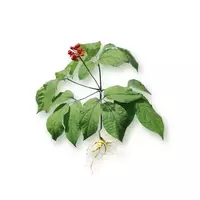Ginseng

Many residents of our latitudes know and even used the unique properties of ginseng. Translated from Chinese, the name of the plant is ginseng or 人參 be translated as "the root of life. " It is no coincidence that ginseng received such a talking name. In science, ginseng is understood as a perennial plant, which is classified as an Araliev family.
Types of ginseng
Currently, researchers know eleven species of ginseng. In the wild or in their natural habitat, all ginseng species are native to Asia and the northern Americas. Due to its healing properties, ginseng belongs to the group of medicinal plants. For thousands of years, residents of the Asian region have been using ginseng in folk medicine.
Composition of ginseng
Some types of ginseng are eaten. The main benefit of ginseng lies in the root of the plant. The plant acquires its distinctive properties due to the unique natural composition of ginseng. The root of the plant contains several groups of compounds that help in the treatment and, which is quite important in the prevention of some diseases.
Ginseng contains saponins, peptides, vitamins of group C, as well as B, macronutrients such as calcium, phosphorus and potassium. In addition, the composition of ginseng is enriched with the following trace elements: iron, zinc, manganese, molybdenum and other substances that are certainly useful for the human body. The main feature and benefit of ginseng can be considered the presence of a unique natural complex of biologically active components in the plant rhizome, which include polyacetylenes, polysaccharides, as well as xatriols.
Ginseng benefits
According to specialists in oriental medicine, ginseng helps to improve the body and return youth to a person. In medicine and pharmacology, the common ginseng root is used, as well as five-leaved and creeping. Ginseng root is harvested in autumn, from plants that have reached the age of five. Ginseng has a biostimulatory, as well as adaptogenic and generalized effect on the human body. The plant has long been used as a natural appetite stimulant.
In the pharmacy you can find a variety of products containing ginseng. As a rule, infusion and phyto tea are used in our latitudes, as well as capsules and tablets containing active components obtained from processing ginseng rhizomes. For culinary purposes one uses seasoning of dried and ground ginseng root.
The harms of ginseng
It is worth emphasizing that in addition to the invaluable benefits, there is also the harm of ginseng to the human body. Therefore, before starting the use of medicines or eating ginseng, it is worth consulting a doctor. Damage to ginseng can occur with individual intolerance to the substances that make up the plant. In addition, do not abuse ginseng and exceed the doses of plant consumption set by doctors.
ginseng 0.1 kCal
Energy value of ginseng (Ratio of proteins, fats, carbohydrates - ju):
Proteins: 0 g (~ 0 kCal)
Fats: 0 g (~ 0 kCal)
Carbohydrates: 0 g (~ 0 kCal)
Energy ratio (b | y): 0% | 0% | 0%
 Español
Español Français
Français Português
Português Русский
Русский 简体中文
简体中文 繁體中文
繁體中文 日本語
日本語 한국어
한국어 العربية
العربية Türkçe
Türkçe Қазақ
Қазақ Deutsch
Deutsch Italiano
Italiano Українська
Українська
